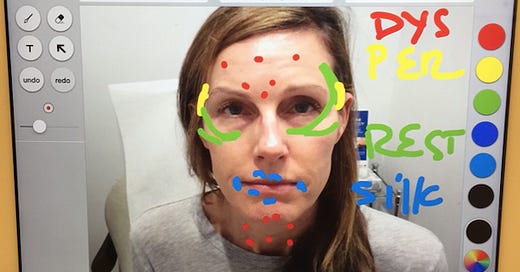What I Learned on the Aging Beat
In her early sixties, Marcia DeSanctis often toggles between the roles of beauty/wellness journalist and lab specimen.
The year I turned 50, I had my first magazine byline, and became what I had always wanted to be: a writer. As I tried to join the ranks of established journalists (and recent college graduates less than half my age), I had to figure out what I could reliably report on, where I could develop expertise, and find actual work. Because of my perspective as a five-decades-old woman, and thanks to a couple of enthusiastic and open editors, I found a natural fit on the beauty and wellness beat.
Aging is a confusing bit of business and it can be difficult to tune out the noise, the maxims, and the endless advice—especially when much of it seems to contradict itself.
The year I turned 50…because of my perspective as a five-decades-old woman, and thanks to a couple of enthusiastic and open editors, I found a natural fit on the beauty and wellness beat.
On one side, we are implored to age without backward glances, exhorted to embrace our wrinkles, and urged to embody that dreaded but glorious chestnut—wisdom, that we have honed by default over many years lived. This approach towards aging is the one that extolls celebrities for eschewing cosmetic procedures, or for letting the gray hair shine. It advocates for self-affirmation, and a radically age-positive approach going forward. It postulates that older women should be the most valued members of our society but above all, that they should value themselves, and not rue time’s relentless steamroller.
The second ideology encourages the opposite: to stop time in its tracks or reverse it altogether—not to embrace our wrinkles but eliminate them, and all the other sags, weaknesses, cracks, pains and hollows that materialize during midlife. The opportunities in this domain were bounteous for a writer in her fifties, who had no shame about pointing an electron microscope on almost every part of her body (even if I deflected when my incredibly smart young editors wondered how old I actually was). Along the way, as I opened a whole cabinet of anti-aging curiosities, I experienced moment after moment of 100-watt clarity, which often illuminated some uncomfortable realities.
For all the bromides about aging gracefully, there was another, often literally painful truth. To grow older, remain in optimal physical and mental health, and keep your appearance dewy-fresh if that is desired, can be arduous, expensive, frustrating, and time-consuming. Deflecting wrinkles, physical atrophy, or worse, insomnia, dementia, chronic illness, depression (not to mention having your roots darkened every eight weeks) takes herculean commitment, relentless determination and even something close to passion.
On one side, we are implored to age without backward glances, exhorted to embrace our wrinkles, and urged to embody that dreaded but glorious chestnut—wisdom, that we have honed by default over many years lived.
Like the best travel stories, these journalistic endeavors ultimately involve a quest, and a hoped-for transformation. Each story is a tidy package of a process of self-improvement, with a beginning: this is the problem I am grappling with; a middle: a collaborating specialist such as a doctor, a facialist, or a trainer outlines the work I need to do, and sheds light on why this work is difficult and crucial; and finally, an end: renewal or metamorphosis achieved, but it’s going to take all the effort I can conjure to keep it going.

Some stories, though not specifically about aging per se, ended up being about exactly that. When it comes to wellness at 61 (my current age), aging—and all the changes our bodies are enduring—is always at the forefront. I have written about my lips, my hip replacement, spider veins, varicose veins, my sagging derriere, my flabby biceps, my alcohol consumption, my sugar addiction, my gut health, my endocrine system, my dependence on processed food, insomnia, Lyme disease, hormone replacement therapy, bad joints, my posture, my bone density, back pain, deflating muscles and lack of upper body strength, my vitamin deficiencies, the epigenetics of aging skin and my probably-damaged microbiome.
I have investigated bras to make my breasts look less deflated and more full, topical collagen to make my crepe-y skin look juicier, and lipstick to accentuate my lips that have been injected with hyaluronic acid. I visited a Swedish dermatologist who was a noted magician with Botox and a pioneer in dermal fillers. “You have lost so much volume in your face,” she told me, preparing a syringe with the goo that would presumably replace it (that time, I chickened out). I lay prone before a Parisian facialist whose treatment cost more than my mortgage. I have sampled 20 different leg makeups, to cover up that which I preferred not to have surgically zapped.
The second ideology encourages the opposite: to stop time in its tracks or reverse it altogether—not to embrace our wrinkles but eliminate them, and all the other sags, weaknesses, cracks, pains and hollows that materialize during midlife.
I have not written specifically about the clinical depression I have lived with for decades, and the rainbow of pharmaceuticals I have consumed to keep that sinister dog at bay. But it often comes up as a supporting player, and surfaces almost everywhere. Depression may be exacerbated by: sleeplessness, Lyme, low estrogen levels, low Vitamin D levels, a suboptimal gut microbiome, sugar and processed foods, lack of regular outdoor exercise. And most of all, aging.
I have worked with estheticians, massage therapists, make-up artists, trainers, butt trainers, coaches; consulted endocrinologists, dermatologists, gynecologists, vascular surgeons, plastic surgeons, equine therapists, sports medicine doctors, dieticians, and many psychologists. I have depended on their expertise and heeded their wisdom. I have leaned into their positivity and patience, and strived to be their most receptive and open fellow traveler. A few years ago, I wrote a story about learning to row, and spent a glorious summer on a glassine lake near my house in rural New England. My coach was so invested in my success, and so emboldening during some of my darkest moments of self-doubt (when I tipped my wafer-thin scull multiple times into the drink), that I wanted to excel not just for me, but for him.
There is a difference between optimizing overall mental and physical health while aging, and consulting a plastic surgeon about a facelift or other cosmetic procedure. But either way, we are all inevitably faced with many decisions: how much am I willing to do to be healthier, fitter, less old-looking as I age? We must all choose what we can and will do to make the unlovely parts of aging more pleasant and less punishing. We should all be free to decide what “aging gracefully” means for us, and be aware of which signs in our bodies are risky to ignore. Those who get neck lifts should not judge those who are content to let the wrinkles proliferate, and those who embrace the deepening folds should not take a dim view of those who wish to iron them out.
We must all choose what we can and will do to make the unlovely parts of aging more pleasant and less punishing. We should all be free to decide what “aging gracefully” means for us, and be aware of which signs in our bodies are risky to ignore.
The more of these journeys I have taken, the more I understand that a magazine assignment is just the beginning of yet another kind of trip: the one that will lead me through my sixties, seventies and hopefully beyond. It is inevitable that along the way, I will face decisions about which broken bits to patch, and which can be left alone. I am not exactly thrilled to spend the last decades of my life in a constant but necessary battle against decrepitude, but within rational limits, I am resigned to a certain amount of never-ending work. And maybe one day, when my chin starts to melt down my neck, perhaps I’ll weigh those options, too.







Here in my late 50s, a lot of this resonates with me. I exercise, I take vitamins, I spend too much money on moisturizers. And I am pained by the knowledge that so much of what women go through at this stage is driven by two terrible things: sexism and capitalism. Our society allows men to have signs of aging without driving them to the mall cosmetic counter or the surgeon, first thing. This is before we even mention the cost, the endless tax on women for daring to show signs of existing past 39! I am a target of relentless marketing for products to "reduce the signs of aging" and the ads are full of women, women, women, never men. How weary this makes me, the constant message that I am not allowed to age and must pay to prevent this shameful product of time from appearing on my face, my body, in public.
I enjoyed this piece, which I read with interest because I am asking myself all those questions about "maintenance." But was I was exhausted half way through the article just reading about all the many measures taken to fend off the inevitable, or the appearance of what is already taking its toll: age. And the cost! Meanwhile, I was interested to learn just how often I would have to pay to have roots dyed should I go that direction. For now I take away gratitude that at 64 I still only have about three grey hairs. While after years of medications for chronic illness which have had ruinous consequences on skin and bones, I prefer to invest in repairing my knees to ensure lasting mobility which finally is more important to me. Rowing sounds like a good plan!